International Approaches
Singapore: where is the poster child of global education heading now?
We look beyond the international league tables
Why is the Singapore approach interesting?
Educational standards were transformed in 40 years through a centralised, prescriptive strategy. Now Singapore’s approach is evolving significantly as the city state plans for the needs of the 21st century.
- Over 50 years, Singapore has moved from low literacy levels to become one of the highest performers globally.
- The Ministry of Education controls curriculum, testing, teaching and schools. Curriculum, assessment and instruction have been closely aligned. Classroom practice has traditionally been relatively scripted and uniform with a heavy reliance on textbooks, worksheets, worked examples and practice.
- Formative and summative assessment are deeply embedded in the Singaporean system. Teachers and students focus heavily on high stakes exams at the end of Primary and Secondary.
The strategy is changing.
- Teachers and schools have been given increasing autonomy and decision-making power with greater opportunity for flexible and creative teaching. The curriculum has been slimmed and testing volume is being reduced.
- Applied Learning Programmes add practical application to learning in schools and vocational education upgraded.
- Singapore’s strategy remains long-term. The curriculum is moving towards skills, creativity and developing the arts as well as new generations of technology. This reflects Singapore’s view of the skills students entering school now will need in 2040.
Singapore’s transformation has been remarkable
- Singapore separated from Malaysia to become an independent state in 1965. The People’s Action Party (PAP), led by Lee Kuan Yew, has been in government since independence.
- With few natural resources apart from being a natural port, raising educational standards has always been a policy priority.
- In 1965 Singapore’s population had low skill and literacy levels and GDP per head similar to Cambodia, Mozambique and Pakistan.
- Economic growth has transformed the nation, GDP has increased 43x (in real terms) since independence. GDP per head is twice the level in the UK.
- Singapore has a free-market, capitalist image but the state retains a deep and significant influence in key sectors:
-
Housing: 79% of residential housing publicly developed
and governed. - Healthcare: individuals/employers pay for 75% of healthcare but the medical insurance system is state organised, most hospitals are state run and drugs prices controlled.
- Economic development: Singapore has long had published, state economic development plans targeting developing in chosen sectors. Government and business work closely together to achieve them.

Prime Minister Lee Kuan Yew giving a television press conference on the separation of Singapore from Malaysia.
Ministry of Information & the Arts Collection, courtesy of National Archives of Singapore.

Singapore, 2021.
Photo by Kenneth Koh on Unsplash
Universal basic education was the first step at a time when Singapore’s position was often fragile
Stage 1: 1959-78 “Survival-driven”
Rolling out access to basic education as quickly as possible
- Rapid school building (1 per month) to give every child a school place.
- Common exam structure created based on the UK system – British ‘O’ and ‘A’ level structures are still central today.
- Teacher numbers doubled to 19,000 between 1959 to 1968 but low morale resulted in high attrition.
- Near universal primary education achieved by 1978.
- 30% of students did not progress to secondary school.
- 40%+ of students failed ‘O’ level / PSLE exams.

Kallang West Government Chinese Middle School, 1956
Centrally structured teaching, curriculum and assessment improvements helped raise standards
Stage 2: “Efficiency-driven” 1979-96
Reducing performance variation across the system
- Created multiple pathways for students, streaming by aptitude.
- Developed system of technical and vocational education with industry links.
- Curriculum Development Institute created in 1980 to develop quality resources to support the development of teachers.
- Regular student assessment introduced to monitor student outcomes and school performance.
- Increasing use of data to inform the strategy.
- Improved performance targeted across all ethnic and socio-economic groups.
- Greater flexibility starts to be introduced in 1990s. Independent Schools introduced in 1988 and Autonomous schools in 1994.

In the 1990s, there was a push to use IT in schools
Teaching professionals have been given more autonomy. There is greater focus on the individual and skills learning
Stage 3: “Ability-driven” 1997 onwards
Steadily moving away from prescriptive control
- Thinking Schools, Learning Nation’ launched.
- Greater focus on the individual student’s learning.
- Curriculum reduced by 30% across subjects.
- Schools gathered into clusters to share best practice and independently self-improve.
- More decision-making power given to education professionals in schools.
- Focus on IT, innovation and new skills.
- School inspection and assessment moves towards self-assessment rather than centralised pressures.
- Professional Learning Communities established with teachers collaborating, reviewing and improving.
Singaporean students score highly in international comparisons
PISA 2018 results by country/region - performance above the OECD average by subject area
Note: Data for China is only for Beijing, Shanghai, Jiangsu & Zhejiang
What is PISA? The Programme for International Student Assessment measures the ability of students to apply skills in reading, mathematics and science. It is done by testing a sample of students to reflect the wider population. The tests are designed to assess interpretation and the application of skills, not memorised knowledge
Singapore comes top of the TIMSS analysis
TIMSS scale centerpoint = 500
What is TIMSS?
Carried out by the International Association for the Evaluation of Educational Achievement, TIMSS is based at at the Lynch School of Education in Boston College. TIMSS stands for the Trends in International Mathematics and Science Study. Data is collected in around 70 countries around the world with the intention that the data supports better evidence-based educational policy making.
Assessment and banding are central to the Singaporean system from the primary years
An overview of Singaporean primary education
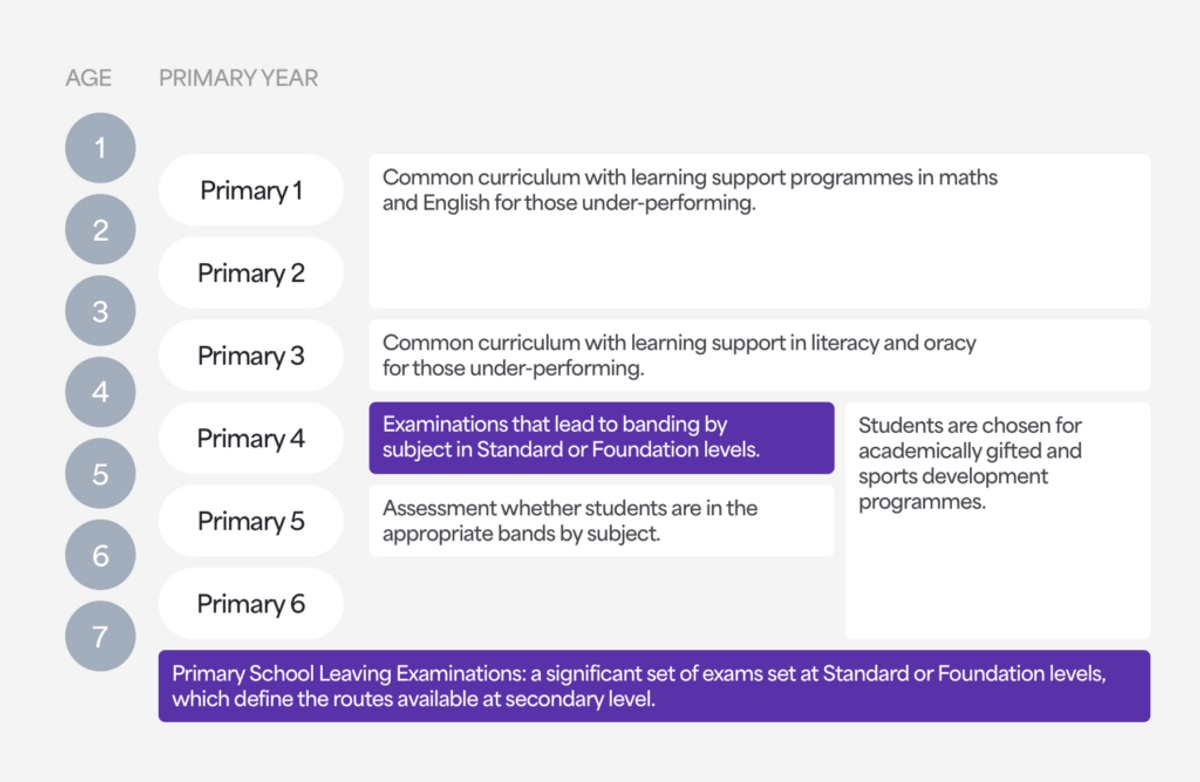
ASSESSMENT
- Traditionally formal assessment used from the earliest primary years but now starts at Primary 4.
- Structured, formative assessment remains integral to the Singaporean approach from early years.
OBJECTIVES
- Use assessment formatively from an early age.
- Recognise student strengths.
- Structural interventions to address weaknesses.
- Actively stream students into learning environments best suited to developing their potential.
The primary school leaving exam streams students into three different paths at secondary
An overview of Singaporean secondary education
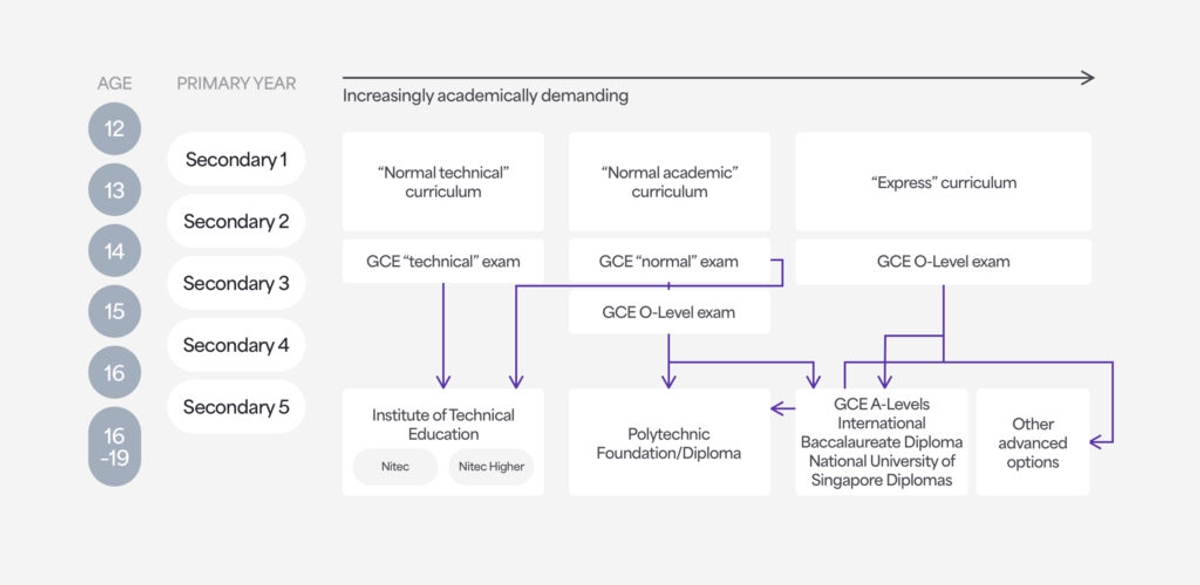
In the classroom there has traditionally been a focus on traditional techniques but this has been changing
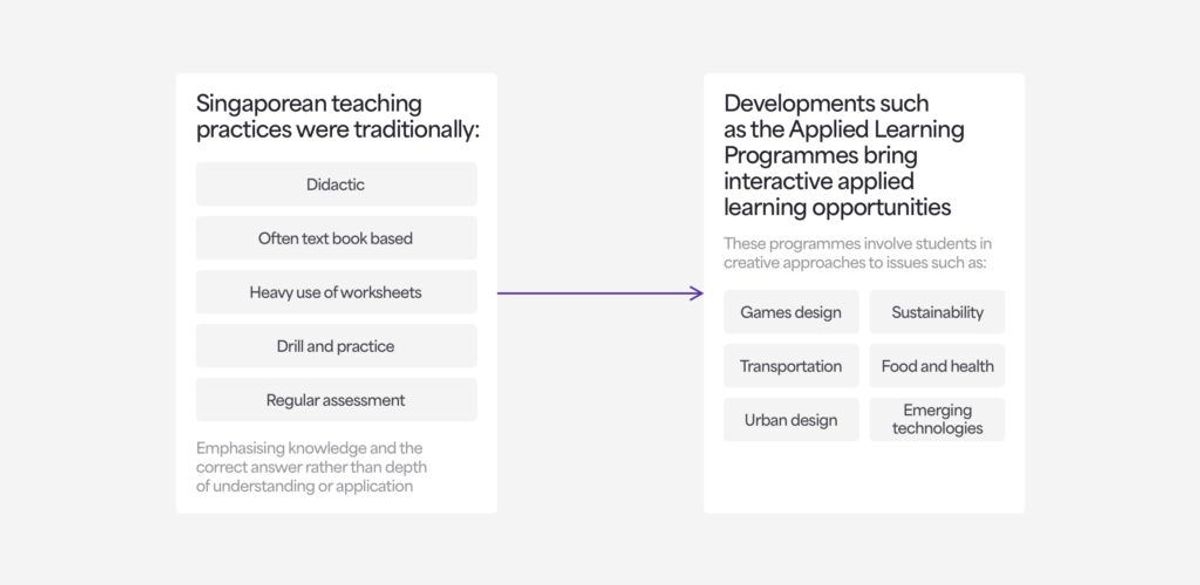
The approach has steadily evolved and continues to do so
Both formative and summative assessment are central to the Singaporean approach
Formative Assessment
- Integral to the teaching approach at all levels.
- Teachers have a student assessment plan established for each year.
- Policy development has encouraged and developed this.
- Embedded through teacher training.
- Movements between learning bands possible through formative assessment of progress.
Summative Assessment
- Mid and end of year exams each year in school (being ended in early primary years).
- Key school exams in Primary 4 (10 years old) lead to banding decisions.
- Primary School Leaver exams (12 years old) lead to Secondary course options.
- Banded GCE exams (Technical, Normal and O level) then decide further available options.
The system is now moving towards 21st century competencies and more holistic student outcomes but the focus on assessment remains strong
Achievement levels are high. Among the ethnic populations Malay students underperform, however
Proportion of Students Passing The PSLE Exams By Subject
Over 90% of all ethnic groups continue education beyond secondary
Proportion Participating In Education Post Secondary School By Cohort
The Singaporean Ministry of Education ensures alignment between each aspect of the education system
- Very clear alignment of all elements including curriculum, teaching and assessment.
- Summative exam assessment is an important part of the approach.
- Institutional and national habits are deeply ingrained. Softening the examination focus has been hard to achieve.
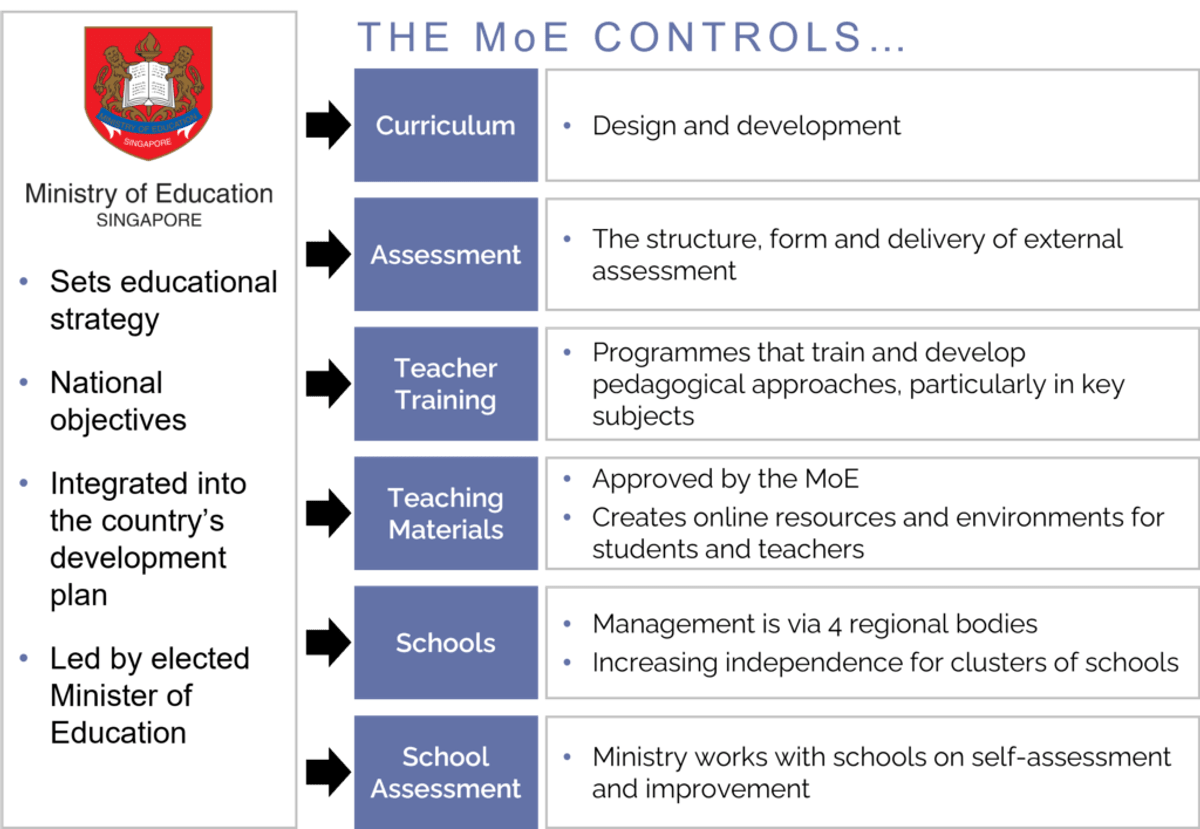
Communication to parents, students and the wider population is clear and powerful.
- Education has always been a central part of government communications.
- Using web, YouTube, social media as well as traditional media to discuss and communicate.
- Targeting students, parents and teachers.
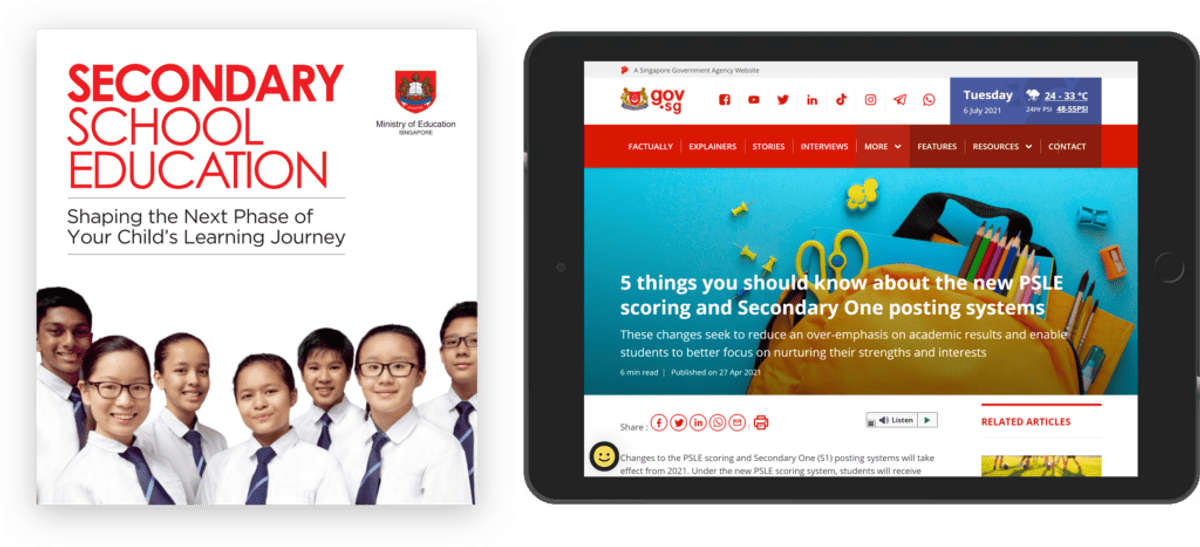
Integrating policy, practice and research involves teachers, schools, academics and government in system improvement
- Research and new practices are an important part of teacher training and development.
- Dynamic relationship between research, policy, and practice enables innovation and improvement
- This is supported by insight-gathering work, international evidence and dialogue with local and global experts.
- Formulation of policies involves extensive engagements and consultations among political leaders, MOE officers, and school stakeholders on the ground. It is common for the MOE to continue engagement after policies are launched.
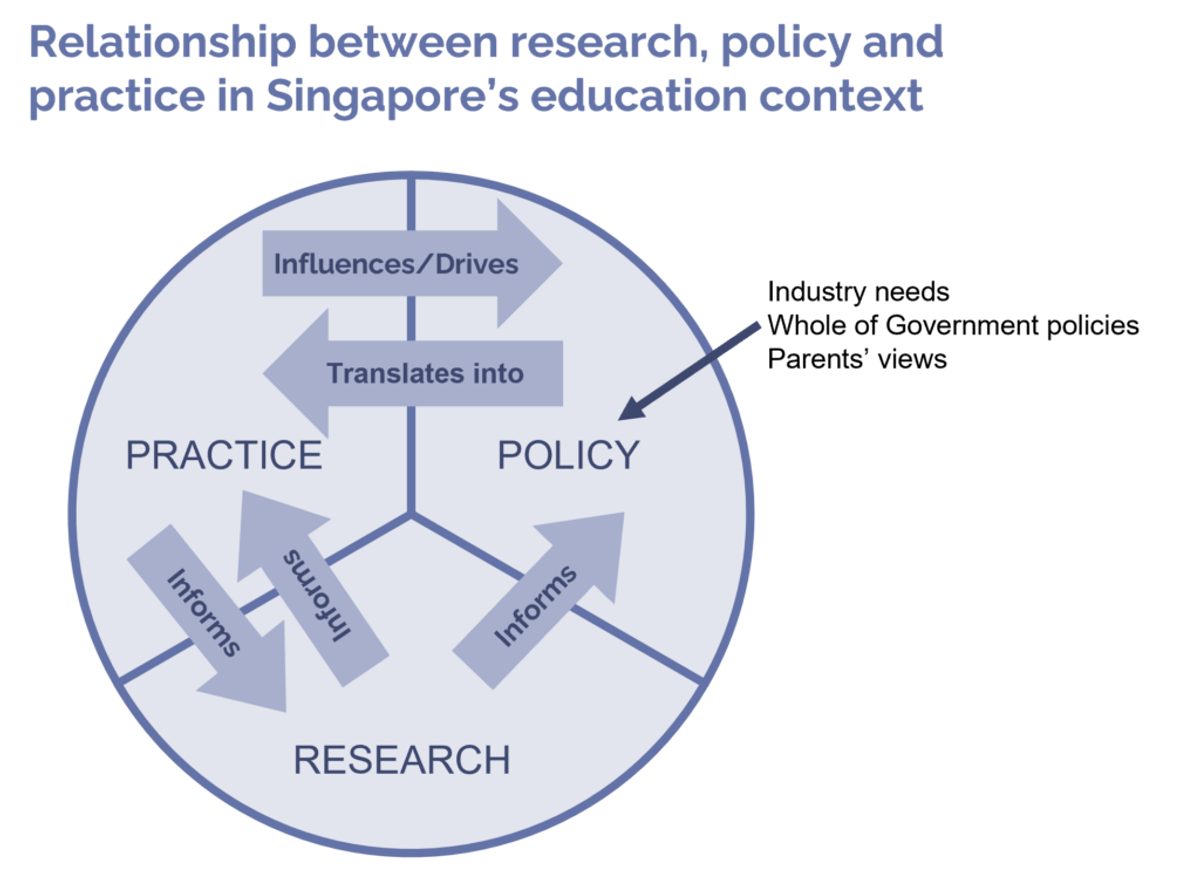
If you ask why the Singapore system works for ourselves, in our context, I would suggest that it is the unity of vision and mission among our teachers, school leaders, union leaders, NIE educators and researchers and policymakers at MOE… All of us, despite our different views and leanings work towards a shared vision of moulding the future of our nation.
Dr. Poon Chew Leng, Director of Research and Evaluation at the Planning Division of the Ministry of Education
Vocational education has made major improvements to become the source of highly respected qualifications
Development of the Institute of Technical Education (ITE) has transformed perceptions of vocational qualifications an attractive route for further and higher education in Singapore.
Previously a weaker part of Singapore’s system, it is now a competitive strength.
The transformation has come in different forms:
- Beautiful, modern buildings with high quality facilities.
- A wider range of courses that go beyond the traditional technical heartland to include the culinary arts, games development, film making, sports and leisure management.
- New courses are directly targeting future growth industries that face global shortages of skilled people such as cyber security, robotics, data engineering,
- International partnerships to enable students to study abroad at other leading vocational institutions such as the Gottlieb Daimler Schule in Germany (engineering) and the Institut Paul Bocluse in France (culinary arts).

ITE College Central, Singapore
Teachers are valued and have strong professional development
The OECD Talis survey 2018 reports that:
- 72% Singaporean teachers agree or agree strongly that their profession is valued in society.
- 89% teachers say they are satisfied with their job and 72% satisfied with their salaries.
- All these figure are significantly above the OECD averages.
- Singaporean teachers are positive about collaboration with colleagues (83% vs 81% average) but the figures for determining course content in class and having a voice in school vision and goals are below OECD averages.
Professional development
- Emphasised as a essential element of the profession and progression.
- Supported by the National Institute of Education at Nanyang University in academic form.
- Active professional development within schools.
- Including research projects developing new teaching approaches.
- Opportunities to carry out research abroad.
Strategy has evolved organically responding to new challenges early
As you can see from the graphic, Singapore's educational strategy has clear evolving themes.
Radical changes or reforms are not part of the approach, each development carefully structured, communicated and implemented gradually.
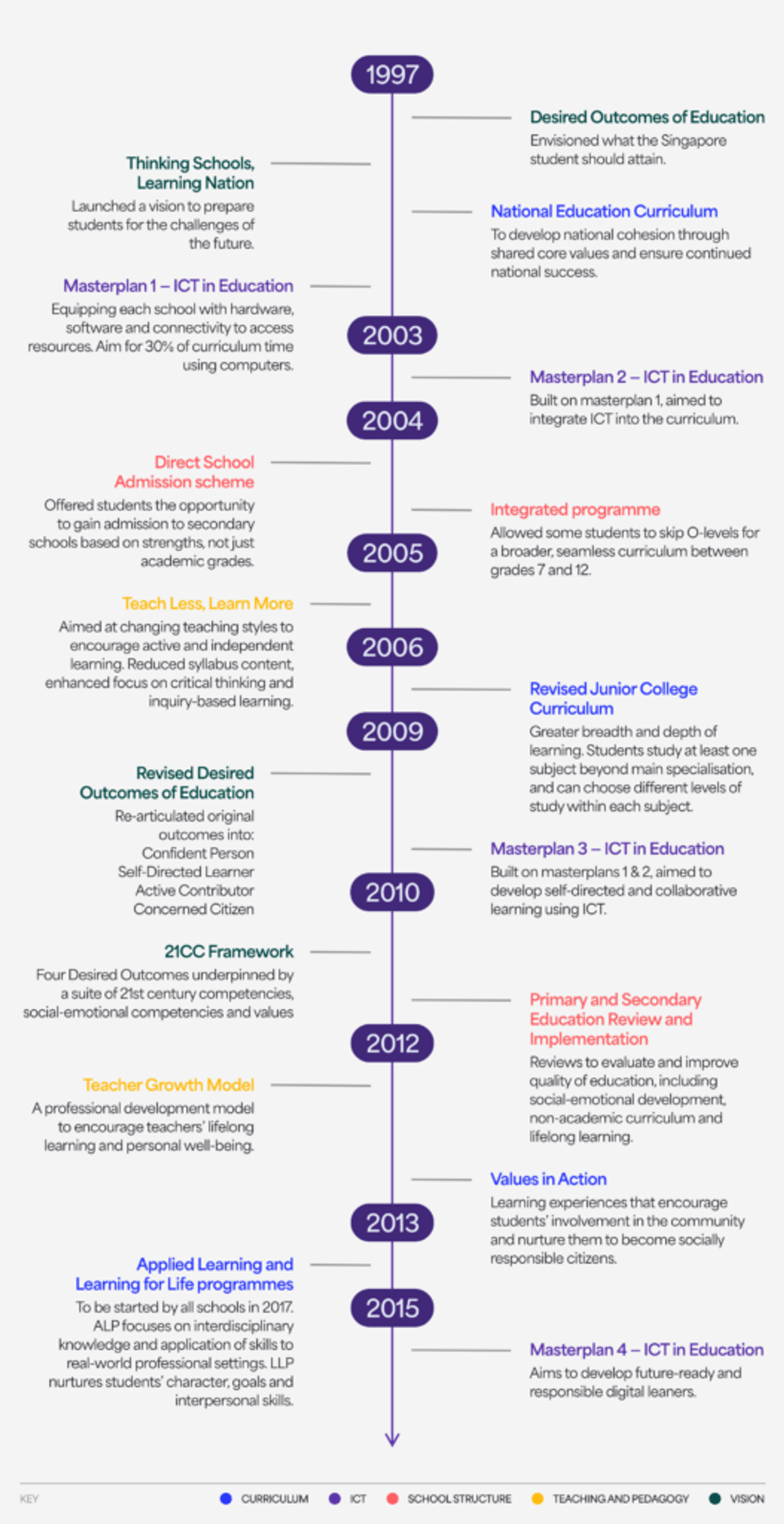
Exam focus is being gently reduced. Reforms are not radical but the direction of travel is clear
Delegating more decision making to schools
- Creating more specialist schools.
- Greater self-assessment and self-improvement rather than central control.
- Pedagogical development by teachers within clusters of schools.
Reducing curriculum load
- The scale of the curricula has been reduced to allow more teaching that is not focused on exams.
- Allowing more skills learning experiences.
- More arts, sport and applied opportunities.
Reducing the number and the competitiveness of exams
- Ending early primary formal assessments.
- Removing half yearly exams in the early years of primary and early years secondary.
- Marking students at PSLE (Primary School Leaving Exam) level against set criteria rather than in comparison to other students.
Softening the banding structures
- Introducing full Subject Based Banding to create more tailored curricula and assessment levels for the range of student abilities.
- Ending the emotive Express and Normal banding names at Secondary.
Skills and competencies are increasingly important to the Singaporean vision for education
Thinking Schools, Learning Nation and subsequent reforms are gently moving the focus towards:
- Skills for the 21st century.
- Fostering innovation and creativity.
- More project work.
- Applied Subjects ranging from drama and sport to robotics.
- The framework of competencies that has been widely communicated to students, parents, teachers and the broader Singaporean population.
Framework for 21st Century Competencies and Student Outcomes
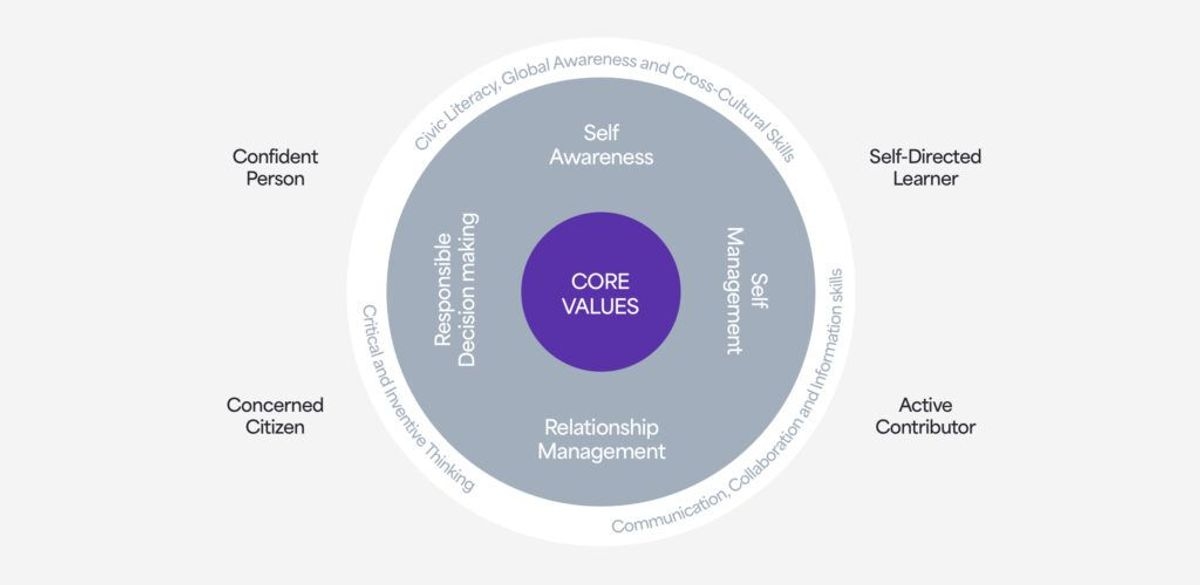
Your child will be nurtured through our secondary-school education to become:
- A Confident Person who has a strong sense of right and wrong, is adaptable and resilient, knows himself, is discerning in judgement, thinks independently and critically, and communicates effectively.
- A Self-directed Learner who questions, reflects and perseveres and takes responsibility for his own learning.
- An Active Contributor who is able to work effectively in teams, is innovative, exercises initiative, takes calculated risks and strives for excellence.
- A Concerned Citizen who is rooted in Singapore, has a strong sense of civic responsibility, is informed about Singapore and the world, and plays an active part in bettering the lives of others around him.
Singapore take-aways
- Organic long-term strategy development has been fundamental to Singapore’s success. There have been no dramatic reforms.
- Teachers are valued and respected in society. Singaporean graduates want to be teachers.
- Curriculum, teaching and assessment have remained closely connected and aligned.
- Central control and traditional teaching of core skills were central to the early waves of development but for the next stage power is being delegated to schools and teachers.
- Vocational education has been upgraded over the last decade through significant investment. Vocational qualifications are now highly regarded.
- Singapore is increasing its focus on skills, applied learning, competencies and a broader curriculum as it evolves the education system for the mid 21st century.
References
Universal basic education was the first step at a time when Singapore’s position was often fragile
Centrally structured teaching, curriculum and assessment improvements helped raise standards
Teaching professionals have been given more autonomy. There is greater focus on the individual and skills learning
OECD, McKinsey, Singaporean Ministry of Education, Singapore Straits Times
Achievement levels are high. Among the ethnic populations Malay students underperform, however
Over 90% of all ethnic groups continue education beyond secondary
Source: Data.gov.sg, managed by Ministry of Education, Singapore
Integrating policy, practice and research involves teachers, schools, academics and government in system improvement
Source: Tan et al. Advancing 21st Century Competencies in Singapore
Skills and competencies are increasingly important to the Singaporean vision for education
Source: https://www.moe.gov.sg/-/media/files/secondary/secondary-brochure-2020.pdf









